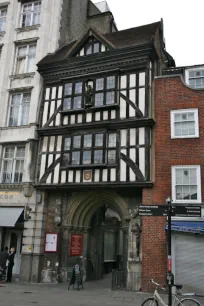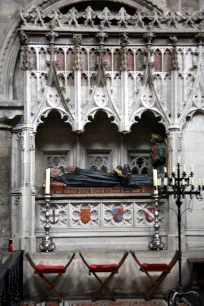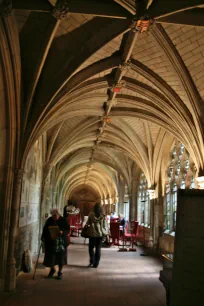St. Bartholomew-the-Great is the oldest monastic church in London. Only a part of the original twelfth century church remains, but it’s still one of the best examples of Norman architecture in London.



History
The founding by Rahere
The church was founded in 1123 by the Augustinian monk Rahere as part of a priory. Rahere was a jester at the court of King Henry I, the son of William the Conqueror. On a pilgrimage to Rome, Rahere became so severely ill with malaria that it caused hallucinations. Rahere believed one of the hallucinations was a vision in which the saint Bartholomew appeared to him and saved him.
After he recovered, Rahere decided to become an Augustinian monk. He founded a priory with an adjoining hospital, dedicated to saint Bartholomew. In the hospital, which still exists today, Rahere and his fellow monks treated the sick poor. The priory contained a large church, St. Bartholomew-the-Great. The priory and church were funded with the proceeds from the Bartholomew Fair, one of London’s largest annual fairs.
Demolishment of the priory
In 1539 the priory was dissolved on the order of King Henry VIII. The priory was acquired by Richard Rich, the Lord Chancellor. Rich demolished much of the priory, including the nave of the church and a part of the cloister. The remaining structures were used for secular purposes and housed a school, a wine cellar, a smithy, a stable and a printing works where Benjamin Franklin worked in 1725.
The Church Today
The church we see today is the result of a restoration carried out by Aston Webb between 1887 and 1928. You reach the church by entering the picturesque gate at Little Britain street. The gate marks the entrance of the former church. The arch is still original, but the half-timbered house above the entrance was built in the sixteenth century, probably by Richard Rich.



Behind the entrance lies a green forecourt with a raised churchyard that now occupies the area where once the ten-bay long nave of the church stood. The current facade, with its checkered patterns, is a creation of Aston Webb. Today’s church is only half the size of the original; the Lady Chapel, the four-bay choir, a small section of the transepts and just one bay of the nave are all that is left of the original church.
Interior
Inside, the church of St. Bartholomew-the-Great is dark and atmospheric. Massive columns with round arches, typical for Romanesque architecture, line the choir. The interior is sparsely decorated aside from a few monuments.
The most notable monument in the church is the tomb of its founder, Rahere. The Gothic tomb, created in 1405, shows the prior praying with at his feet an angel. Two kneeling monks by his side are reading from the bible. The angel holds a shield decorated with the arms of the priory: two lions below two crowns. Other notable monuments include the tomb of Sir Walter Mildway, Chancellor under Queen Elisabeth I, and a monument to Robert Chamberlayne from 1615 which shows a kneeling figure below a canopy, flanked by two angels.
Behind the choir is the Lady Chapel, restored in 1896. The painting of the Madonna and Child is a recent addition: it was painted in 1998 by Alfredo Roldan, a Spanish artist. The High Altar in the sanctuary is also from the twentieth century, created in 1950 by Seely and Paget. Much older is the oriel window on the south aisle. It was created around 1517 by William Bolton, an accomplished builder who was the prior of St. Bartholomew’s from 1505 until 1532.
Cloister
To the south of the church, near the gatehouse, is the Cloister Café, housed in a beautifully vaulted ambulatory, the only part that remains of the Augustinian priory’s cloister.
The cloister was originally built in 1160, but rebuilt in 1405. Three bays survived the sixteenth century demolition of the priory. They were used as stables until 1905 when they were restored. In 1923-1928, Webb reconstructed the other bays of the cloister’s north ambulatory.

